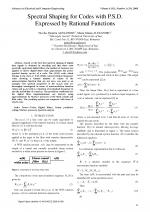| 1/2008 - 6 |
Spectral Shaping for Codes with P.S.D. Expressed by Rational FunctionsALEXANDRU, N. D. |
| Extra paper information in |
| Click to see author's profile in |
| Download PDF |
Author keywords
Codes, Digital filters, Linear predictive coding, Markov processes, Spectral analysis
References keywords
signals(4), digital(4), codes(4), alexandru(4)
Blue keywords are present in both the references section and the paper title.
About this article
Date of Publication: 2008-04-02
Volume 8, Issue 1, Year 2008, On page(s): 31 - 35
ISSN: 1582-7445, e-ISSN: 1844-7600
Digital Object Identifier: 10.4316/AECE.2008.01006
Web of Science Accession Number: 000259903500006
SCOPUS ID: 67749131182
Abstract
Based on the fact that spectral shaping of digital data signals is obtained by encoding and that there exist spectrally equivalent digital filters, the method of Justesen was applied to derive digital filters that approximate the power spectral density (p.s.d.) of a code. The (2,2,3) code, which belongs to the class of FAS (Finite Autocorrelation Sequence) codes showing a limited number of values of the autocorrelation function that are not zero, was used as an example. The spectral properties of the (2,2,3) code are thoroughly investigated in terms of autocorrelation function values and p.s.d. both as a function of normalised frequency fn and the probability of a mark p. The prediction coefficients for the digital filter implementations are derived using approximations by Markov processes of the third, fourth and fifth order. The resulting spectra are compared with those of (2,2,3) code. |
| References | | | Cited By |
Web of Science® Times Cited: 0
View record in Web of Science® [View]
View Related Records® [View]
Updated 2 weeks, 5 days ago
SCOPUS® Times Cited: 3
View record in SCOPUS® [Free preview]
View citations in SCOPUS® [Free preview]
[1] Improved Nyquist Filters with a Transfer Characteristic Derived from a Staircase Characteristic Interpolated with Sine Functions, ALEXANDRU, N. D., POHOATA, S., Advances in Electrical and Computer Engineering, ISSN 1582-7445, Issue 2, Volume 9, 2009.
Digital Object Identifier: 10.4316/aece.2009.02016 [CrossRef] [Full text]
[2] Calculus of the Power Spectral Density of Ultra Wide Band Pulse Position Modulation Signals Coded with Totally Flipped Code, DURNEA, T. N., ALEXANDRU, N. D., Advances in Electrical and Computer Engineering, ISSN 1582-7445, Issue 1, Volume 9, 2009.
Digital Object Identifier: 10.4316/aece.2009.01003 [CrossRef] [Full text]
Disclaimer: All information displayed above was retrieved by using remote connections to respective databases. For the best user experience, we update all data by using background processes, and use caches in order to reduce the load on the servers we retrieve the information from. As we have no control on the availability of the database servers and sometimes the Internet connectivity may be affected, we do not guarantee the information is correct or complete. For the most accurate data, please always consult the database sites directly. Some external links require authentication or an institutional subscription.
Web of Science® is a registered trademark of Clarivate Analytics, Scopus® is a registered trademark of Elsevier B.V., other product names, company names, brand names, trademarks and logos are the property of their respective owners.
Faculty of Electrical Engineering and Computer Science
Stefan cel Mare University of Suceava, Romania
All rights reserved: Advances in Electrical and Computer Engineering is a registered trademark of the Stefan cel Mare University of Suceava. No part of this publication may be reproduced, stored in a retrieval system, photocopied, recorded or archived, without the written permission from the Editor. When authors submit their papers for publication, they agree that the copyright for their article be transferred to the Faculty of Electrical Engineering and Computer Science, Stefan cel Mare University of Suceava, Romania, if and only if the articles are accepted for publication. The copyright covers the exclusive rights to reproduce and distribute the article, including reprints and translations.
Permission for other use: The copyright owner's consent does not extend to copying for general distribution, for promotion, for creating new works, or for resale. Specific written permission must be obtained from the Editor for such copying. Direct linking to files hosted on this website is strictly prohibited.
Disclaimer: Whilst every effort is made by the publishers and editorial board to see that no inaccurate or misleading data, opinions or statements appear in this journal, they wish to make it clear that all information and opinions formulated in the articles, as well as linguistic accuracy, are the sole responsibility of the author.



